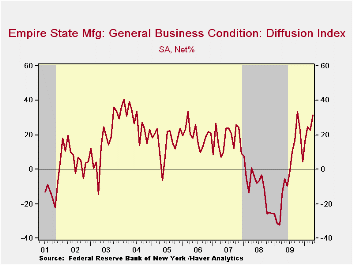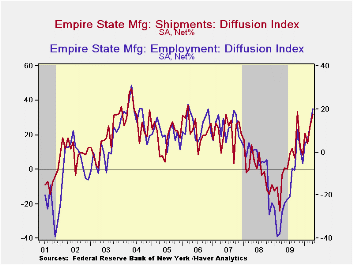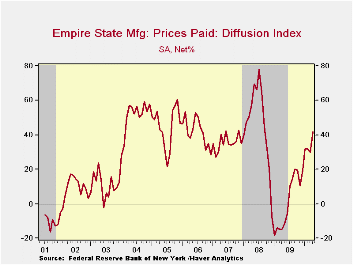 Global| Apr 16 2010
Global| Apr 16 2010Empire State Business Conditions Show Further Gain
by:Tom Moeller
|in:Economy in Brief
Summary
Forward momentum is building behind business conditions in the Northeast region of the country. The Federal Reserve Bank of New York reported that its April Empire State Factory Index of General Business Conditions rose to its highest [...]

Forward momentum is building behind business conditions in the Northeast region of the country. The Federal Reserve Bank of New York reported that its April Empire State Factory Index of General Business Conditions rose to its highest level in six months. As a result it was near the highest since 2004. At 31.86, the diffusion index was up from its recession low of -32.29 in March 2009. The latest level suggests positive growth in factory sector activity and it beat Consensus expectations for a reading of 24.0.
The figure is a diffusion index. Since the series' inception in 2001, there has been a 74% correlation between its level and the three-month change in U.S. factory sector production. Like the Philadelphia Fed Index of General Business Conditions, the Empire State Business Conditions Index reflects answers to independent survey questions; it is not a weighted combination of the components. The series dates back only to 2001.
Amongst the separate survey questions, shipments and inventories rose strongly. Also strong was the employment index which rose to 20.25, near its highest since 2004 There has been an 87% correlation between the employment index and the three-month growth in factory sector employment as reported by the Labor Department.
The prices paid index rose m/m to 41.77, its highest since September 2008. Since inception there has been a 76% correlation between the index of prices paid and the three-month change in the core intermediate materials PPI.
The Empire State index of expected business conditions in six months held steady m/m and was near the highest since early-2004. The capital expenditure and technology spending series both remained near the highest levels since the recession began.
The Empire State Manufacturing Survey is a monthly survey of manufacturers in New York State. Participants from across the state in a variety of industries respond to a questionnaire and report the change in indicators from the previous month. Each index is seasonally adjusted. Respondents also state the likely direction of these same indicators six months ahead. For more on the Empire State Manufacturing Survey, including methodologies and the latest report, click here. The Empire State data is available in Haver's SURVEYS database.


| Empire State Manufacturing Survey | April | March | February | April '09 | 2009 | 2008 | 2007 |
|---|---|---|---|---|---|---|---|
| General Business Conditions (diffusion index, %) | 31.86 | 22.86 | 24.91 | -14.59 | -2.76 | -9.97 | 17.22 |
| New Orders | 29.49 | 25.43 | 8.78 | -3.99 | -2.52 | -6.22 | 15.70 |
| Inventories | 11.39 | 4.94 | 0.00 | -35.96 | -22.89 | -7.87 | -3.95 |
| Employment | 20.25 | 12.35 | 5.56 | -28.09 | -17.28 | -5.36 | 11.28 |
| Prices Paid | 41.77 | 29.63 | 31.94 | -14.61 | 1.33 | 46.99 | 35.64 |
Tom Moeller
AuthorMore in Author Profile »Prior to joining Haver Analytics in 2000, Mr. Moeller worked as the Economist at Chancellor Capital Management from 1985 to 1999. There, he developed comprehensive economic forecasts and interpreted economic data for equity and fixed income portfolio managers. Also at Chancellor, Mr. Moeller worked as an equity analyst and was responsible for researching and rating companies in the economically sensitive automobile and housing industries for investment in Chancellor’s equity portfolio. Prior to joining Chancellor, Mr. Moeller was an Economist at Citibank from 1979 to 1984. He also analyzed pricing behavior in the metals industry for the Council on Wage and Price Stability in Washington, D.C. In 1999, Mr. Moeller received the award for most accurate forecast from the Forecasters' Club of New York. From 1990 to 1992 he was President of the New York Association for Business Economists. Mr. Moeller earned an M.B.A. in Finance from Fordham University, where he graduated in 1987. He holds a Bachelor of Arts in Economics from George Washington University.






